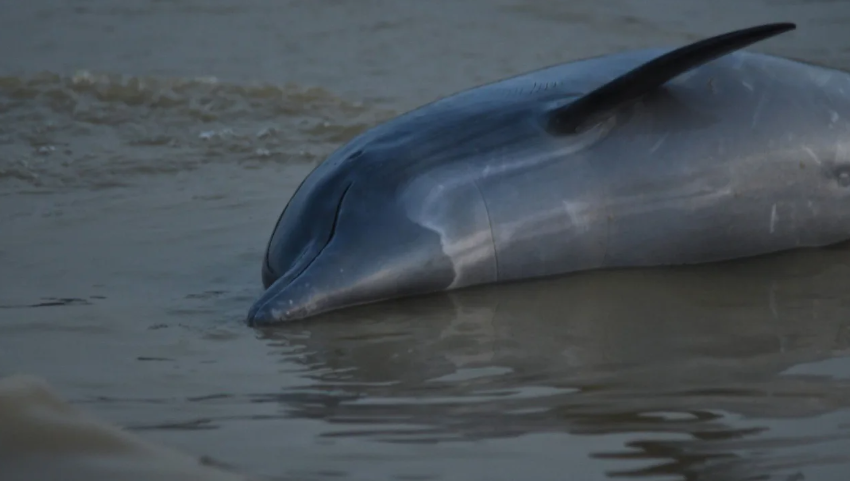
©André Zumak/Mamirauá Institute
Vocabulary:
I will read the words, meanings, and sample sentences. Then, repeat after me.
- attribute /uh-TRIB-yoot/
- drought /drout/
- fragile /FRAJ-uhl/
- caution /KAW-shuhn/
- mortality /mawr-TAL-i-tee /
[verb] – to say or think that something is the result of a particular thing
Many scientists attribute the recent increase in wildfires to climate change.
[noun] – a long period when there is little or no rain
The region suffered from a severe drought, causing water shortages.
[adjective] – easily destroyed, ended, or made to fail
The delicate ecosystem of the rainforest is incredibly fragile and easily disrupted.
[verb] – to warn someone
It’s essential to caution hikers about the potential dangers of the steep trail.
[noun] – the number of deaths within a particular society and within a particular period of time
The mortality rate in the area spiked during the flu outbreak.
Article reading:
Please read the whole article. Then, I will check your pronunciation and intonation.
In a devastating environmental crisis, over a hundred dolphins have been discovered lifeless in the Brazilian Amazon, primarily within Lake Tefé, within the last week. This alarming phenomenon is attributed to a historic drought and soaring water temperatures, surpassing 102 degrees Fahrenheit in some areas. The Mamirauá Institute, a research establishment supported by the Brazilian Ministry of Science, has confirmed the unprecedented number of dolphin fatalities and posited that the extreme lake temperatures and the Amazon’s record-breaking drought may be the root causes. Climate scientists are increasingly alarmed by the implications of such events on the Amazon’s fragile ecosystem and the impact of human activities on the region. The Amazon River, the largest in the world, is presently in its dry season, further exacerbating the situation and endangering various species of river fauna. Efforts are underway to rescue surviving dolphins, with researchers and activists endeavoring to transfer them from lagoons and ponds in remote areas to the main river body, where the water is cooler. However, this operation is fraught with challenges due to the region’s inaccessibility.
André Coelho, a researcher at the Mamirauá Institute, cautioned that transferring river dolphins to different rivers is not without risks, as it is essential to assess the presence of toxins or viruses before releasing them into the wild. The drought’s impact extends beyond the ecological sphere, affecting the region’s economy. Approximately 59 municipalities in Amazonas State have reported below-average water levels, impeding transportation and fishing activities on the river. Authorities are bracing for even more severe droughts in the coming weeks, which could exacerbate the dolphin mortality rate, as reported by CNN Brasil.
André Coelho, a researcher at the Mamirauá Institute, cautioned that transferring river dolphins to different rivers is not without risks, as it is essential to assess the presence of toxins or viruses before releasing them into the wild. The drought’s impact extends beyond the ecological sphere, affecting the region’s economy. Approximately 59 municipalities in Amazonas State have reported below-average water levels, impeding transportation and fishing activities on the river. Authorities are bracing for even more severe droughts in the coming weeks, which could exacerbate the dolphin mortality rate, as reported by CNN Brasil.
Discussion Questions:
I will read each question. Then, please answer them.
- Have you ever encountered or witnessed an environmental crisis or natural disaster that had a profound impact on the local ecosystem or wildlife? If yes, please describe your experience and how it affected your perception of environmental issues. If not, can you imagine the emotions and challenges that researchers and activists in the Brazilian Amazon are facing while trying to rescue dolphins during this crisis, and how such events could raise awareness about climate change?
- Do you think that transferring river dolphins to different rivers as a rescue effort is a viable solution in the face of extreme environmental conditions like drought and soaring temperatures? If yes, what precautions do you think should be taken to ensure the safety of the dolphins? If not, can you suggest alternative strategies for mitigating the impact of climate-related events on fragile ecosystems and endangered species like Amazon river dolphins?
- Do you believe that climate change and its impact on ecosystems, as highlighted in the article about the Brazilian Amazon dolphins, require immediate global attention and action?
- How might the interplay of factors such as drought, soaring temperatures, and the Amazon’s fragile ecosystem create a domino effect of ecological consequences? What lessons can we learn from this situation for addressing climate-related challenges elsewhere?
- In the article, André Coelho cautions about the risks of transferring river dolphins without assessing toxins or viruses. What ethical considerations should guide the actions of researchers and conservationists in situations where interventions may have unintended consequences? How can science and conservation efforts strike a balance between urgent action and responsible decision-making?
Summarization
Please summarize the whole article using your own words and expressions. You will have one minute to prepare before you answer.
Describe:
Please explain the definition of each word listed below based on your understanding. You can provide example sentences if needed.
- surpass
- underway
- unprecedented
- establishment
- phenomenon